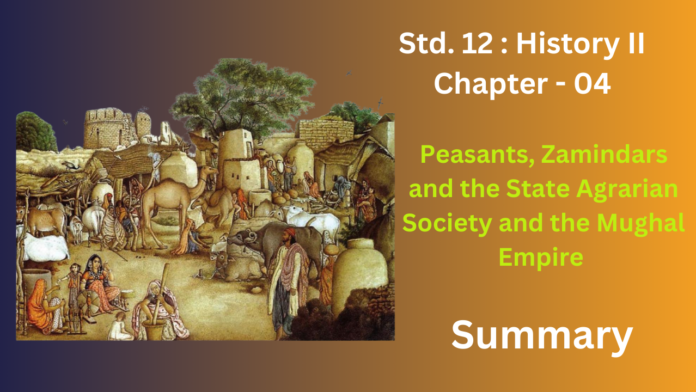This chapter focuses on the structure and functioning of rural society during the Mughal Empire in the 16th and 17th centuries. Peasants, who were also referred to as raiyats or muzarians, cultivated various crops like rice, wheat, pulses, and also cash crops such as sugarcane, indigo, and cotton. Although the land was officially owned by the state, peasants were given the right to till the land and pass it on to their heirs. This system included land measurement and tax collection based on the productivity of the land. Peasants were often required to pay revenue in cash or kind, which sometimes became a burden for them, especially in years of poor harvest.
Another important group in rural society was the zamindars. They were local landholders or chiefs who collected revenue from peasants and kept a share for themselves before passing the rest to the state. Many zamindars held hereditary rights over their land and people, and some were very powerful and influential. They played a key role in maintaining order in the villages and often acted as intermediaries between the state and the rural population. Village society was also deeply influenced by caste, kinship ties, and local customs. Despite the dominance of the Mughal administration, villages remained strong social and economic units with their own traditional systems.
In essence, this chapter shows how agrarian society under the Mughal Empire was a mix of state control, local traditions, and economic relationships. The connection between peasants, zamindars, and the state formed the foundation of the Mughal economy and rural life.
Exercise
1. What are the problems in using the Ain as a source for reconstructing agrarian history? How do historians deal with this situation?
Ans:
The Ain-i-Akbari is a valuable source for studying Mughal agrarian history, but it comes with certain limitations. One major issue is that it presents an ideal picture of the empire, focusing on how things were supposed to function rather than how they actually did. Since it was compiled by a court historian, it reflects the imperial perspective and may overlook the conditions of ordinary peasants. Also, much of the information is based on official records, which may not capture regional differences or irregularities in revenue collection and farming practices.
To handle these challenges, historians compare the Ain with other sources such as local revenue documents, records from regional kingdoms, travelers’ accounts, and even inscriptions. They also use archaeological findings and study rural customs and practices to understand everyday life in villages. By using a variety of sources, they can create a more accurate and balanced picture of agrarian life in Mughal India.
2. To what extent is it possible to characterise agricultural production in the sixteenth-seventeenth centuries as subsistence agriculture? Give reasons for your answer.
Ans:
Agricultural production during the sixteenth and seventeenth centuries was not entirely subsistence-based, although a large portion of rural India did practice it. Most peasants grew food crops such as rice, wheat, pulses, and millets mainly for their own consumption and to meet the basic needs of their families. This form of farming was common, especially in areas where access to markets was limited.
However, alongside subsistence agriculture, commercial farming also began to emerge in many regions. Crops like cotton, indigo, sugarcane, and opium were cultivated specifically for trade and sale. These were often sold in local markets or exported, indicating the growing importance of market-driven agriculture. The Mughal administration’s system of collecting land revenue in cash further pushed farmers toward growing crops that had market value.
Therefore, while subsistence farming dominated in many areas, agricultural production during this time had a strong commercial element as well.
3. Describe the role played by women in agricultural production.
Ans:
Women play a crucial role in agricultural production, especially in rural and developing areas. They are actively involved in almost every stage of farming, from preparing the land and sowing seeds to wedding, watering, and harvesting crops. In addition to crop production, women also contribute significantly to animal husbandry by taking care of livestock, feeding them, and managing dairy activities. They are responsible for processing food products, storing grains, and preserving seeds for the next season. Many women maintain kitchen gardens that provide essential vegetables and herbs for household consumption, improving family nutrition. Furthermore, women often participate in local markets to sell farm produce, supporting the household economy. Despite their hard work, they frequently face limited access to resources such as land, credit, training, and modern tools. Recognizing their efforts and providing them with proper support is essential for strengthening agricultural development and ensuring food security.
4. Discuss, with examples, the significance of monetary transactions during the period under consideration.
Ans:
Monetary transactions played a significant role in shaping the economy and society during the historical period under consideration. The use of money as a medium of exchange marked a shift from the earlier barter system, making trade more efficient and organized. Coins made of metals like gold, silver, and copper began to circulate, facilitating both local and long-distance trade. For example, during the Mauryan period in India, punch-marked coins were widely used, which helped in the growth of internal trade and market towns. Similarly, during the Gupta period, gold coins called dinars were issued, reflecting the prosperity of the empire and the importance of trade with foreign lands. Monetary transactions also enabled the collection of taxes by rulers in the form of currency rather than goods, which strengthened the administrative systems. The rise of merchants, moneylenders, and trade guilds further illustrates how monetary systems influenced economic activities and social structures. Overall, the introduction and expansion of monetary transactions played a vital role in promoting trade, urbanization, and state formation.
5. Examine the evidence that suggests that land revenue was important for the Mughal fiscal system
Ans:
Land revenue was the backbone of the Mughal fiscal system and played a central role in the administration and economy of the empire. A major portion of the Mughal state’s income came from taxes collected on agricultural land. The importance of land revenue is evident from the detailed revenue records maintained during the reign of Emperor Akbar, especially through the efforts of his finance minister, Raja Todar Mal. He introduced a systematic land revenue system known as the Zabt system, which involved careful measurement of land and assessment of crop production.
Further evidence lies in the Ain-i-Akbari, a part of Abul Fazl’s Akbarnama, which provides comprehensive data on land revenue rates, methods of assessment, and the role of revenue officials. It shows how the Mughal state categorized land, estimated yields, and fixed tax rates accordingly. Revenue collection was so crucial that a large number of officials, such as amil, qanungo, and patwari, were employed specifically for managing land records and ensuring tax collection.
The Mughal emperors also granted jagirs (land revenue assignments) to nobles and officials instead of salaries, which further highlights the economic value of land revenue. Overall, both documentary records and administrative practices confirm that land revenue formed the foundation of the Mughal fiscal system and was essential for maintaining the empire’s stability and military strength.
Write a short essay (about 250-300 words) on the following:
6. To what extent do you think caste was a factor in influencing social and economic relations in agrarian society?
Ans:
Caste played a significant role in shaping social and economic relations in agrarian society, especially in pre-modern India. It acted as a key factor in determining a person’s occupation, social status, and access to resources. The hierarchical nature of the caste system ensured that land ownership and control over agricultural production remained concentrated in the hands of the upper castes, particularly the Brahmins, Rajputs, and other dominant landowning communities.
The lower castes, especially the Shudras and Dalits, were generally landless laborers or tenants who worked on the fields of upper-caste landlords. They had limited rights and were often exploited for their labor. Social customs and practices strictly regulated interactions between different castes, reinforcing economic inequalities. For example, lower castes were not allowed to enter temples or use wells meant for upper castes, reflecting their marginalization in both social and economic spheres.
Caste also influenced the division of labor. Occupations were traditionally hereditary, and people were expected to follow the professions assigned to their caste. In many villages, caste councils or panchayats enforced social rules and ensured that the caste hierarchy was maintained.
However, it is also important to note that there were regional variations, and in some areas, economic factors like landownership and access to irrigation could challenge traditional caste roles. Over time, with changing political and economic conditions, such as the introduction of new land revenue systems and market-based agriculture, the rigid boundaries of caste began to blur slightly, though caste remained a dominant influence
7. How were the lives of forest dwellers transformed in the sixteenth and seventeenth centuries?
Ans:
During the sixteenth and seventeenth centuries, the lives of forest dwellers across the world underwent dramatic changes due to colonial expansion, state policies, and economic transformations. In regions like India, Africa, and the Americas, indigenous tribes and forest-based communities faced increasing encroachment on their lands. European colonial powers, along with centralized empires like the Mughals, sought to control forests for timber, minerals, and agriculture. This led to large-scale deforestation, as trees were cut down for shipbuilding, plantations, and urban development. Traditional practices like shifting cultivation were banned or restricted, forcing many tribes to abandon their way of life and become laborers in fields, mines, or construction projects. Many communities were displaced as their territories were taken over for cash crops like cotton, indigo, or sugarcane. In Latin America, the Spanish forced indigenous people into harsh labor systems like the encomienda, while in India, British forest laws criminalized tribal hunting and gathering. Missionaries also played a role in altering tribal societies by converting them to Christianity and suppressing their traditional beliefs.Despite these pressures, forest dwellers resisted through rebellions. In India, tribes like the Santhals and Gonds rose up against oppressive landlords and colonial rulers, while in North America, the Pueblo Revolt of 1680 temporarily drove out Spanish colonizers. However, these movements were often crushed, leaving tribes marginalized in the new economic order. By the end of the seventeenth century, many forest communities had been pushed into poverty, their autonomy eroded by state control and global trade networks. Their struggles during this period laid the groundwork for later movements fighting for land rights and cultural survival.
8. Examine the role played by zamindars in Mughal India
Ans:
Zamindars played a crucial role in the administrative and agrarian structure of Mughal India. They were powerful landholders who held significant influence over rural society and acted as intermediaries between the state and the peasants. The Mughal Empire recognized their importance and often relied on them to collect land revenue from the cultivators.
Zamindars were responsible for maintaining law and order in their areas, collecting taxes, and ensuring that agricultural production continued smoothly. In return, they retained a share of the revenue as their income. Many zamindars also had their own soldiers and fortresses, which gave them considerable local power and autonomy. They often acted as patrons of art, culture, and religion, building temples, mosques, and tanks to gain social respect and legitimacy.
Though they were part of the Mughal administrative system, some zamindars were hereditary chiefs or local rulers who retained traditional authority over their regions. Others were appointed by the Mughals for their loyalty and service. The position of zamindars varied greatly—some were very wealthy and influential, while others controlled only a few villages.
At times, tensions arose between zamindars and the Mughal state, especially when revenue demands were high or when they resisted central control. Rebellions by zamindars were not uncommon, and they sometimes challenged imperial authority. However, their cooperation was essential for the stability of the Mughal rural economy.
9. Discuss the ways in which panchayats and village headmen regulated rural society
Ans:
In Mughal India, panchayats (village councils) and village headmen played an important role in regulating rural society. The panchayat was usually composed of respected elders from the dominant castes of the village and acted as a local governing body.
He was responsible for collecting land revenue, maintaining law and order, and supervising agricultural activities. He also represented the village in dealings with government officials and ensured that taxes were paid on time.
Their decisions were respected and accepted by the villagers as they were based on local customs and traditions. In cases of conflict, the panchayat worked to restore harmony and prevent violence within the community.
These local institutions also had the authority to impose fines or social boycotts on those who disobeyed village rules. In this way, they ensured discipline and maintained social harmony. The panchayat also took care of community resources such as grazing lands, ponds, and village temples.
In many cases, the panchayat and the headman also played a role in helping the poor by distributing relief during times of famine or crisis. They managed village funds and made collective decisions for the welfare of the community.


